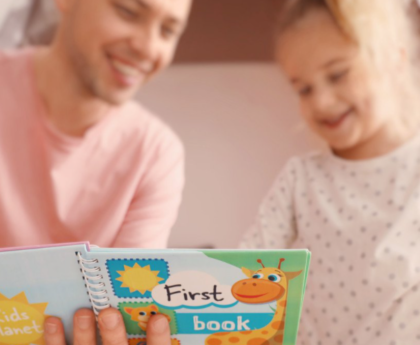Bedtime reading creates magical moments that children treasure for years. These quiet minutes together not only strengthen your bond but also build essential literacy skills while helping your child wind down for sleep.
Why Bedtime Reading Matters
Bedtime reading routines provide consistent exposure to language, vocabulary, and story structures that support literacy development. During these calm moments, children can focus fully on the story without the distractions of daytime activities.
The Science of Reading shows that regular exposure to books and rich language builds the foundation for reading success. Children who hear stories nightly develop stronger vocabulary, better comprehension skills, and a deeper understanding of how stories work.
Beyond literacy benefits, bedtime reading creates emotional security and positive associations with books. Children who experience reading as a loving, comforting activity are more likely to become lifelong readers.
Benefits of bedtime reading:
- Builds vocabulary through rich story language
- Develops listening comprehension skills
- Creates positive associations with books
- Provides calming transition to sleep
- Strengthens parent-child bonding
- Establishes consistent daily routine
Even 10-15 minutes of bedtime reading makes a significant difference in your child’s literacy development and emotional well-being.
8 Sweet Bedtime Reading Ideas
Here are some wonderful ideas.
1. Story and Snuggle Time
Create the ultimate cozy experience by gathering soft blankets, favorite stuffed animals, and settling in for story time. Let your child choose whether to sit beside you, on your lap, or nestled under your arm. This physical closeness makes reading feel safe and special while building positive associations with books.
Choose books that match your child’s mood and energy level. Some nights call for gentle, soothing stories, while others might need slightly more engaging tales to capture attention before settling down.
2. Take Turns Reading Adventure
Once your child can read simple books, alternate pages or sentences. You read one page, they read the next. This shared reading builds confidence while keeping them engaged throughout longer stories.
For beginning readers, let them read the easier sentences while you handle the challenging parts. As their skills grow, they can take on more of the reading. This gradual release of responsibility builds reading skills and confidence.
3. Character Voice Extravaganza
Bring stories to life by giving each character a unique voice. Make the bear sound gruff, the mouse squeaky, and the princess elegant. Children love hearing their parents be silly and dramatic with character voices.
Don’t worry about being a professional voice actor – even simple changes in pitch or accent make characters feel real and memorable. Your child might start creating their own character voices too, building their storytelling skills.
4. Choose Your Own Adventure Nights
Let your child pick the book, where to sit, and even what order to read multiple short books. Giving children control over some aspects of bedtime reading increases their engagement and investment in the routine.
You might set up a special basket with 3-4 book options and let them choose. Or let them decide whether to read one longer book or two shorter ones. These small choices make children feel empowered and excited about reading time.
5. Series Journey Together
Start a chapter book series that you read together over several weeks or months. Series like Henry and Mudge, Mercy Watson, or Magic Tree House create anticipation and give you shared characters to discuss.
End each night’s reading at an exciting moment so your child looks forward to the next installment. Talk about what might happen next and let your child make predictions about the story.
6. Themed Reading Weeks
Choose a theme for the week and find books that match – dinosaurs, trucks, princesses, or animals. This approach helps children explore topics deeply while building specialized vocabulary around their interests.
Visit the library together to find books that match your chosen theme. Let your child help select which books to include in your themed week. This involvement builds excitement and ownership of the reading experience.
7. Memory Lane Reading
Share books from your own childhood or family favorites passed down through generations. Tell your child about when you first heard the story or who read it to you. These connections create special family memories and traditions.
Don’t worry if the books seem old-fashioned or different from current favorites. Children often love hearing about their parents’ childhood experiences and connecting with family history through shared stories.
8. Quiet Independent Looking Time
For children who resist bedtime, offer quiet time looking at books independently in their room after your shared reading time. Provide a small basket of favorite books and a soft reading light.
This extended book time helps very active children settle down gradually while building independent reading habits. They can “read” familiar books, look at pictures, or simply enjoy quiet time with books before sleep.
Age-Appropriate Bedtime Reading Approaches
Different ages need different approaches to bedtime reading to maximize both enjoyment and developmental benefits.
Toddlers (18 months – 3 years): Keep it simple with short board books, repetitive text, and lots of pictures. Don’t worry if your toddler wants to hear the same book every night for weeks – repetition builds language skills and provides comfort.
Let toddlers help turn pages and point to pictures. They might not sit still for entire stories, and that’s normal. Follow their lead and keep the experience positive.
Preschoolers (3-5 years): Expand to longer picture books with more complex stories. Ask simple questions about characters and plot to build comprehension skills. “What do you think will happen next?” or “How do you think the character feels?”
Preschoolers can handle slightly longer reading sessions and enjoy more detailed illustrations. They often love silly books and stories with humor or surprise elements.
School-age children (5+ years): Include chapter books, beginning reader books they can help with, and continued picture book favorites. Don’t feel like you need to abandon picture books completely, even older children enjoy beautiful illustrations and sophisticated picture book stories.
School-age children can engage in deeper discussions about stories, make connections to their own experiences, and handle more complex plots and character development.
Handle Bedtime Reading Challenges
Common challenges can disrupt bedtime reading routines, but most have simple solutions that keep the routine positive and consistent.
When Children Resist Bedtime Reading
Sometimes children resist bedtime reading because they want to delay sleep or they’re overtired. Try moving reading time earlier in the bedtime routine or shortening the session temporarily.
Make sure your child has some choice in the routine – which book to read, where to sit, or whether to have a snack during reading. Small amounts of control can reduce resistance.
When Schedules Get Disrupted
Life happens and bedtime routines sometimes get interrupted by late activities, travel, or busy evenings. Don’t abandon the routine completely – even five minutes of reading maintains the habit and provides comfort.
Consider abbreviated versions for challenging nights: one short book, reading while your child brushes teeth, or even telling a simple story without a book when you’re away from home.
When Children Want the Same Book Repeatedly
Many children go through phases of wanting the same book every night. This repetition actually builds language skills and provides emotional comfort, so embrace it rather than fighting it.
You can suggest alternating the favorite book with new choices: “We’ll read your favorite book and then one new book” or “Three nights of your choice, then I get to pick one.”
Build Lifelong Reading Habits
Consistent bedtime reading routines create positive associations with books that last throughout childhood and into adulthood. Children who experience reading as a comforting, enjoyable part of their day are more likely to choose reading for pleasure as they grow.
Long-term benefits:
- Stronger family bonding and communication
- Better academic performance across subjects
- Higher likelihood of becoming lifelong readers
- Improved emotional regulation and coping skills
- Enhanced imagination and creativity
The time you invest in bedtime reading routines pays dividends throughout your child’s educational journey and beyond. These quiet moments together create memories that both you and your child will treasure.
Remember that perfect routines aren’t necessary – consistent, loving interactions with books matter more than elaborate setups or lengthy sessions. Even busy families can find ways to incorporate brief bedtime reading that strengthens both literacy skills and family bonds.
Create Lasting Reading Memories
Bedtime reading routines offer precious opportunities to connect with your child while building essential literacy skills. Whether you choose elaborate themed weeks or simple snuggle sessions with favorite books, the key is consistency and enjoyment.
These quiet moments together create positive associations with reading that support your child’s academic success and personal enjoyment of books throughout their life. The memories you create during bedtime reading become treasured family traditions that your child may continue with their own children someday.
Start tonight with just one book and a cozy spot. Your child’s literacy development and your family’s bedtime routine will both benefit from this simple but powerful tradition.
Ready to enhance your bedtime reading routine with systematic skill-building? The Reading.com app complements your family’s reading time with engaging activities that reinforce the literacy skills your child encounters in bedtime stories. Our structured approach helps children apply what they hear during read-alouds to their own reading development. Start your 7-day free trial today and support your child’s reading growth both day and night!





